The Apple iPad Pro Review
by Ryan Smith, Joshua Ho & Brandon Chester on January 22, 2016 8:10 AM ESTDisplay
With the iPad Pro, one of the main points of interest is its display. Although there are other elements to the iPad Pro like the stylus and the keyboard, the display is really the centerpiece of this tablet, especially when neither the Apple Pencil nor the Smart Keyboard come included with the iPad Pro itself. I think it goes without saying that everyone wants to have a great display on a tablet, but what determines a great display is often in question.
While it’s obvious that less reflectance is better, as is higher contrast and maximum brightness, things like gamma and color reproduction are often subjective as the same color will often look different to different people. In order to try and deal with this issue, we focus on testing all mobile displays to the same color accuracy standards. For now, the industry standard gamut is the sRGB gamut, along with power 2.2 gamma. Although the sRGB gamut is relatively limited compared to something like DCI-P3 or Rec. 2020, it remains an industry standard when compared to what exists on the market today. In order to test how well a display meets these standards in addition to other criteria, we use an i1Pro2 spectrophotometer for accurate color measurements along with an i1Display Pro for accurate contrast measurements. In order to organize this data into a readable format we use SpectraCal’s CalMAN 5 with a custom workflow.
In the case of the iPad Pro, it’s obvious that the architecture of the display is different from what we’ve seen in mobile devices before. Due to the sheer resolution, it seems that Apple is electing to use embedded Display Port (eDP) instead of the more traditional MIPI DSI interface used in smartphones. We’ve seen a number of smartphones and tablets this year ship with an 8 lane MIPI DSI configuration which allows for a theoretical maximum of 2715x1697 for about 4.6MP, but the 2732x2048 resolution of the iPad Pro means about 20% more pixels than what a 2 port MIPI DSI configuration can handle.

Source: design-reuse.com
By comparison, eDP has been able to support 4K at 60 Hz or higher for quite some time. This is self-evident by looking at the number of laptops launched with a 4K display. With the iPad Pro, Apple claims that they’ve implemented their own custom timing controller or TCON. Some digging through the system files seems to corroborate these claims as there are numerous references to an Apple Agile DP Display SAC Controller. That’s a mouthful, but Agile seems to be the internal name for this controller, and DP seems to be a reference to DisplayPort, while SAC is likely a reference to Slow Adaptive Clocking.
Slow Adaptive Clocking is something that there's very limited public information on at this time. My best guess here is that this is actually related to the variable refresh rate technology that Apple is implementing in their custom TCON. On the surface this technology seems to bear a lot of resemblance to G-Sync or FreeSync, but rather than varying refresh rate to fit the GPU’s rendering rate the refresh rate only has two distinct settings at 60 Hz and 30 Hz depending upon whether the content on the display would benefit from the higher refresh rate. It’s likely that at least part of the reason why this is possible is the use of indium gallium zinc oxide (IGZO) TFTs which don’t leak current in the off state. This means that when there is a longer period of time between display refreshes, the liquid crystal retains its state rather than fading towards its original state of either completely open or closed to the backlight.
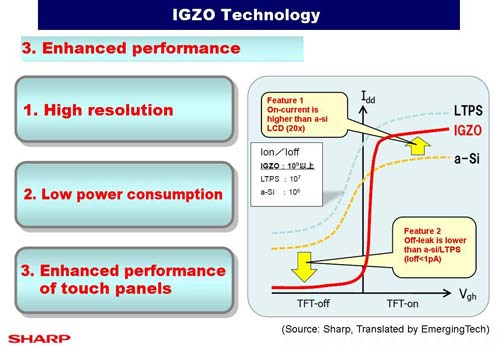
Source: semiconportal.com
In addition to this adaptive refresh rate, the TCON supports panel self-refresh which is hardly news, but given that we’ve seen phones and tablets in this year ship without panel self-refresh it’s worth mentioning.
The panel itself also appears to have dual domain pixels and a conventional RGB stripe. Viewing angles as a result are quite good. The cover glass also contains the AR coating first introduced with the iPad Air 2, which cuts reflectance roughly in half relative to a display that doesn’t have such a coating. This effectively doubles outdoor contrast, so it’s great for outdoor use.
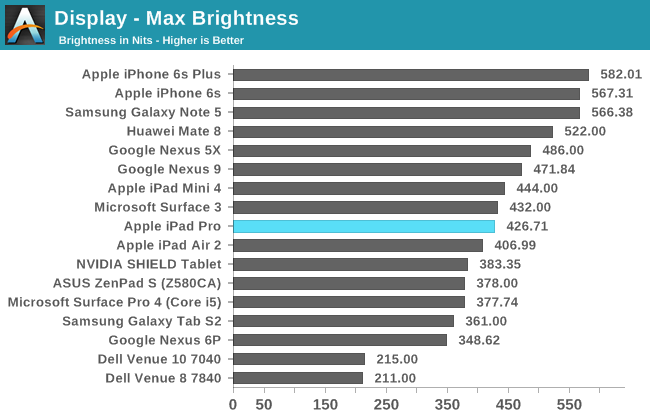
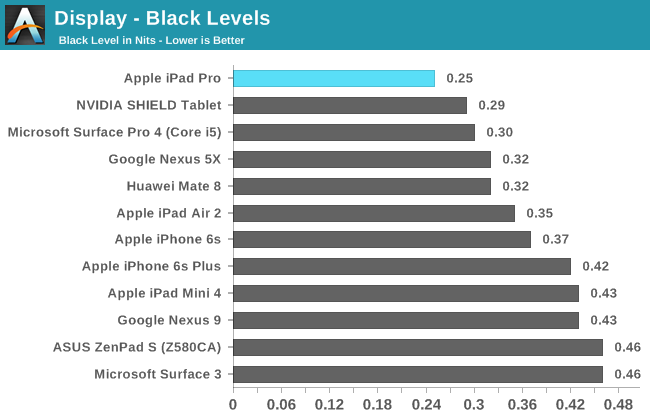
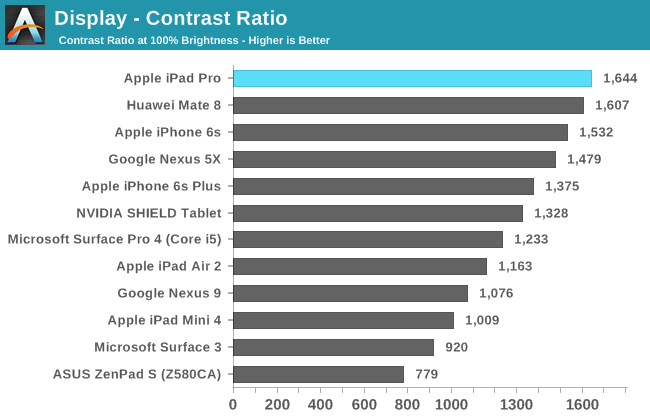
In our standard test of brightness and contrast, it’s evident that Apple has moved to a new generation of display for the iPad Pro as the maximum brightness is mildly improved relative to the iPad Air 2. The real change here though is that contrast is dramatically improved over the iPad Air 2.
This is likely due to the use of photoalignment for the liquid crystals, which helps the liquid crystal to have a more consistent orientation. For those that aren’t really familiar with the particulars of how light polarization and polarizers work, part of the problem is that when a voltage is applied to change the structure of the liquid crystals parts of the liquid crystals won’t necessarily change in structure appropriately. In order to assist with this process a film is applied which gains a particular orientation when exposed to UV light in a specific way. This helps to get the liquid crystals to all align in the same direction, which improves contrast as a result. Of course, contrast isn’t the dark, inky blacks that you'll get with AMOLED but it'll still be quite impressive for normal use.
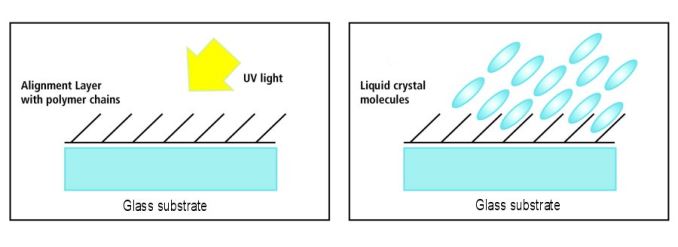 Source: eetimes.com
Source: eetimes.com
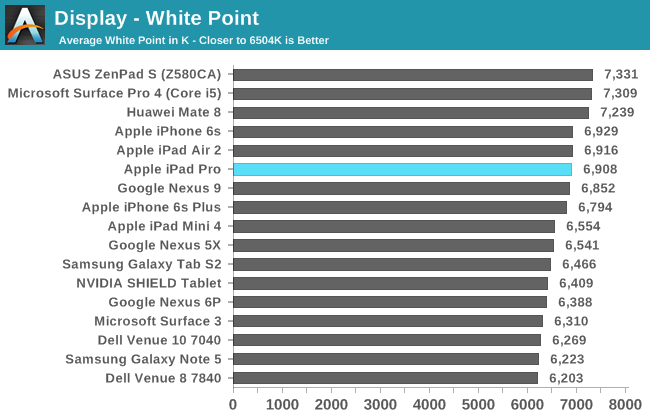
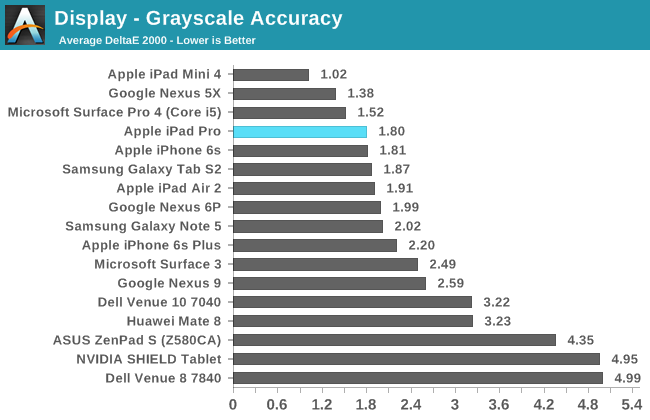
Moving on to our grayscale test, the iPad Pro does impressively well overall with well-controlled gamma but tending slightly towards a colder color balance. I’m not sure whether this is because of backlight efficiency concerns due to the use of blue LED with yellow phosphor in the backlight or because people seem to prefer colder white balances in general, but it’s there nonetheless. The cold color balance might affect some particularly color critical work but even for medical use I suspect it shouldn’t be a serious problem.
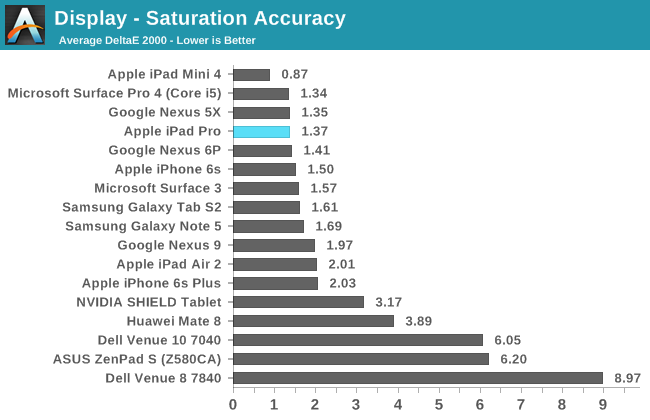
In saturations, the iPad Pro is basically perfect. There is some mild undersaturation of red, but I basically see no reason to try and find some method of personally calibrating the display.
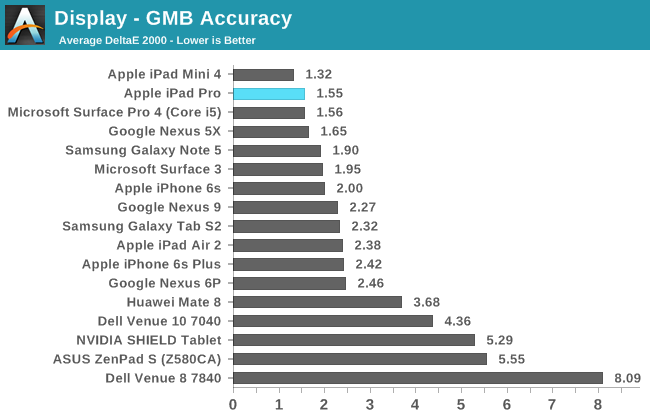
In the Gretag MacBeth ColorChecker test, color error is once again basically nonexistent. Anything with red appears to be mildly undersaturated but the error is going to be almost impossible to notice.
Overall, the iPad Pro display is probably one of the best available on the market today. The Galaxy Tab S2 display is comparable in overall accuracy and has superior contrast, but the iPad Pro has noticeably higher brightness for all content above 50% APL and in any scenario with a lot of ambient background light the AR coating will help a lot with improving effective contrast and general readability. Although pixel density is equivalent to the iPad Air 2, the sheer size of the display means that the viewing distance is increased and therefore the perceived resolution. The display looks great in person, and unless your single point of consideration for display performance is contrast I think it’ll be hard to be disappointed with the iPad Pro display.


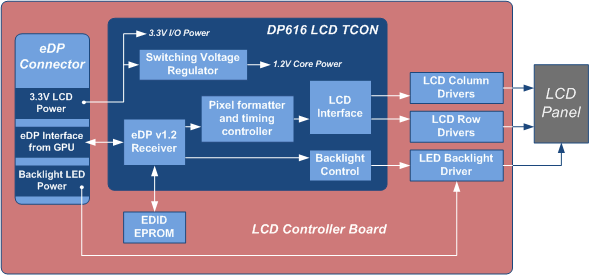
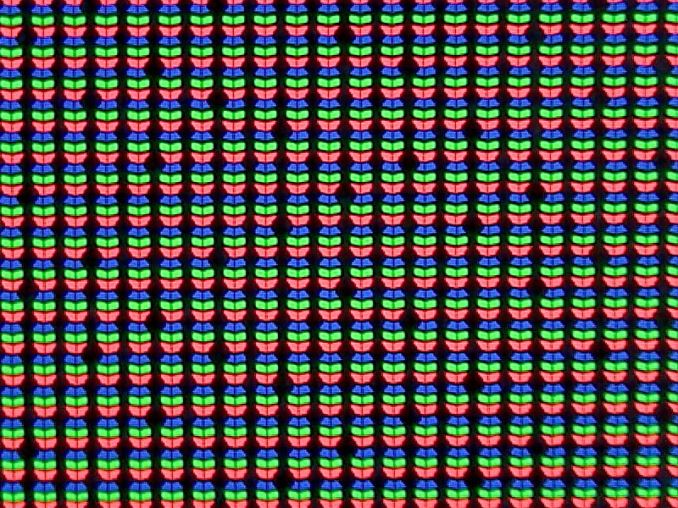

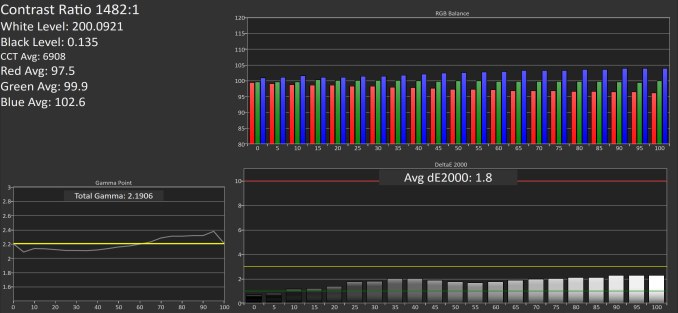
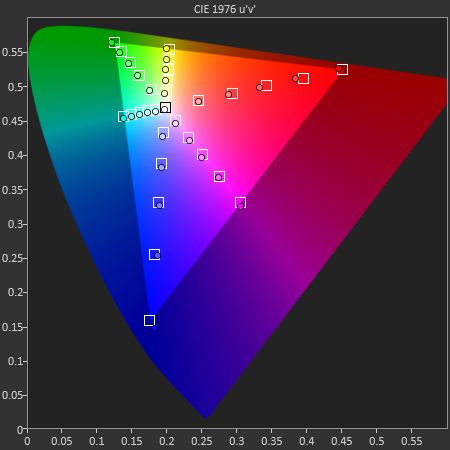
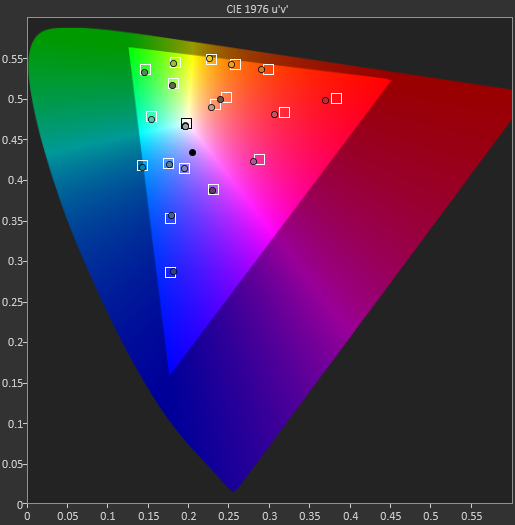








408 Comments
View All Comments
dsraa - Sunday, January 24, 2016 - link
You guys are a bit late reviewing this, no? Especially for a ipad that is the exact same thing, only a little bigger.....what a stupid idea,.....But of course idiots are gonna buy it cause its apple.valentin-835 - Sunday, January 24, 2016 - link
I'm buying it not because it's an Apple. It's the only one out there. Samsung had a 12 inch and they have discontinued it. As for Surface, I don't have a need for desktop apps on my tablet ( not yet ). If that makes me an idiot, so be it.blackcrayon - Sunday, January 24, 2016 - link
People that buy it are "idiots", yet you think the iPad Pro is the "*exact* same thing"? Not sure if you need a dictionary or what.osxandwindows - Sunday, January 24, 2016 - link
What a stupid comment.NitT - Sunday, January 24, 2016 - link
I am interested in iPad Pro because of the pen. Most of my tablets have active digitizer. I have never used iPad as there was no active digitizer available. I have a few Galaxy tablets before with active stylus. However below is my workflow. Please suggest if iPad Pro could handle my workflow.1. I have 200+ email per day and my company's cloud is very limited. It is only 2 GB so I have to archive my email every 15 days. Now I am using Outlook client. I have to access my email from 2013 or 2014 from time to time.
2. My office works are mainly on Office suite either Word, Excel, PowerPoint. I need to copy content from one work (eg. Word) to another one (eg. Excel).
3. I use OneNote heavily and require to copy content from Word/Excel/PowerPoint
to OneNote for note taking.
4. I use Outlook extensively for email, calendar and task. I prefer everything in one place and do not want to go to multiple apps to access those information.
digiguy - Sunday, January 24, 2016 - link
Your workflow seems more typical of a laptop than of a tablet. It wouldn't be impossible to use the ipad pro, but it's definitely not the best device for that. A surface pro 3/4 (or even book) would be a much better option, especially if you copy and past a lot and (seem to) need the full office suite. Also if you want a fanless device, you have more options with similar devices such as the Lenovo Miix 700 and the HP Spectre X2.osxandwindows - Sunday, January 24, 2016 - link
Strange.There are no ms fanboys claiming, surface is better.
Surface is better as a laptop, not as a tablet.
Same go's for the iPad pro, the best professional tablet, not very good as a laptop.
KPOM - Sunday, January 24, 2016 - link
Different tools for different tasks.amrs - Monday, January 25, 2016 - link
From the final words: "Android has some pretty severe issues with making a tablet UI that is more than just a scaled-up phone UI". What exactly are these severe issues? As I understand it the main issue with Android tablets has been apps: few apps lead to few sales so few apps. Video works and is apparently huge in some places but for other apps Microsoft's Office is one of the few good tablet apps on Android... Not talking about the 7-8" tablets where phone UI is usually OK.ABR - Monday, January 25, 2016 - link
Not sure if this is why the article says that, but the iOS APIs make it very clearcut and simple to build a UI that adapts to tablets and phones in standard ways. Android provides some of the building blocks, but leaves you much more on your own for putting it all together. So, while it's actually easier on Android to build the UI that simply expands and shrinks for the screensize, providing two separate modes for tablet-size and phone-size is mostly up to you.